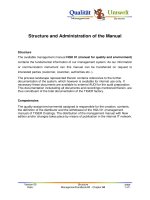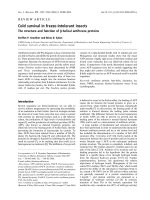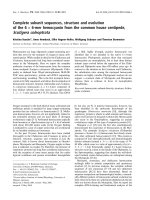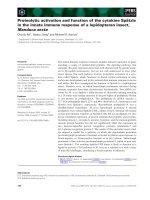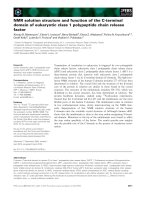structure and function of the arabic verb
Bạn đang xem bản rút gọn của tài liệu. Xem và tải ngay bản đầy đủ của tài liệu tại đây (2.19 MB, 249 trang )
STRUCTURE AND FUNCTION OF
THE ARABIC VERB
Structure and Function of the Arabic Verb is a corpus-based study that unveils the
morpho-syntax and the semantics of the Arabic verb.
Approaches to verbal grammatical categories – the constituents of verbal
systems – often rely on either semantic–pragmatic or syntactic analyses. This
research bridges the gap between these two distinct approaches through a detailed
analysis of Taxis, Aspect, Tense, and Modality in Standard Arabic. This is
accomplished by showing, first, some basic theoretical concerns shared by both
schools of thought and, second, the extent to which semantic structures and
invariant meanings mirror syntactic representations.
Maher Bahloul’s findings also indicate that the basic constituents of the verbal
system in Arabic, namely the Perfect and the Imperfect, are systematically
differentiated through their invariant semantic features in a markedness relation.
Finally, this study suggests that the syntactic derivation of verbal and nominal
clauses are sensitive to whether or not verbal categories are specified for their feature
values, providing therefore a principled explanation to a long-standing debate.
This reader-friendly book will appeal to both specialists and students of Arabic
linguistics, language, and syntax.
Maher Bahloul is Assistant Professor of English and Linguistics at the American
University of Sharjah.
ROUTLEDGE ARABIC LINGUISTICS SERIES
General Editor: Clive Holes, University of Oxford
Editors:
El-Sa’id Badawi, American University in Cairo
Adrian Gully, University of Exeter
Yasir Suleiman, University of Edinburgh
Keith Walters, University of Texas
The Routledge Arabic Linguistics Series publishes high-quality, academically
rigorous research on Arabic linguistics to two main readerships: non-Arabist general
linguists with an interest in Arabic, and students and researchers already in the field
of Arabic language and linguistics. Both synchronic and diachronic studies of Arabic
are welcome which aid our understanding of the historical evolution and the present
state of Arabic, whether dialectal or standard. Works written from a sociolinguistic
(e.g. language variation), socio-historical (e.g. language history), sociological
(e.g. language planning), or psycholinguistic (e.g. language acquisition) perspective
are welcome, as are studies of Arabic stylistics, pragmatics, and discourse analysis.
Descriptive dialectological works also fall within the scope of the Series, as do works
which focus on the evolution of medieval Arabic linguistic thought. Proposals or
scripts for the Series will be welcomed by the General Editor.
Previously Published by Curzon:
MEDIEVAL ISLAMIC PRAGMATICS
Sunni legal theorists’ model of textual communication
Mohamed Mohamed Yunis Ali
JEWISH AND MUSLIM DIALECTS OF MOROCCAN ARABIC
Jeffrey Heath
LANGUAGE CONTACT AND LANGUAGE CONFLICT
IN ARABIC
Variations on a sociolinguistic theme
Edited by Aleya Rouchdy
Published by Routledge:
STRUCTURE AND FUNCTION OF THE ARABIC VERB
Maher Bahloul
STRUCTURE AND
FUNCTION OF THE
ARABIC VERB
Maher Bahloul
First published 2008
by Routledge
2 Park Square, Milton Park, Abingdon, Oxon OX14 4RN
Simultaneously published in the USA and Canada
by Routledge
270 Madison Ave, New York, NY 10016
Routledge is an imprint of the Taylor & Francis Group,
an informa business
All rights reserved. No part of this book may be reprinted or
reproduced or utilised in any form or by any electronic, mechanical,
or other means, now known or hereafter invented, including
photocopying and recording, or in any information storage or
retrieval system, without permission in writing
from the publishers.
British Library Cataloguing in Publication Data
A catalogue record for this book is available from the British Library
Library of Congress Cataloging in Publication Data
Bahloul, Maher, 1963–
Structure and function of the Arabic verb / Maher Bahloul.
p. cm. – (Routledge Arabic linguistics series)
Includes bibliographical references and index.
1. Arabic language – Verb. I. Title.
PJ6145.B34 2007
492.7'5–dc22 2007003135
ISBN10: 0–415–77215–X (hbk)
ISBN10: 0–203–94556–5 (ebk)
ISBN13: 978–0–415–77215–0 (hbk)
ISBN13: 978–0–203–94556–8 (ebk)
This edition published in the Taylor & Francis e-Library, 2007.
“
To purchase your own copy of this or any of Taylor & Francis or Routledge’s
collection of thousands of eBooks please go to www.eBookstore.tandf.co.uk.”
ISBN 0-203-94556-5 Master e-book ISBN
© 2008 Maher Bahloul
TO AMAL, NOUR, AND RAYAN
CONTENTS
List of illustrations xi
Foreword xiii
Acknowledgments xv
List of abbreviations xvii
List of symbols xix
1 Introduction 1
The language and the data 2
Background assumptions 3
Organization of the study 4
2 Verbal categories, clause structure, and modality 7
Introduction 7
Verbal categories and sentence structure 8
Verbal categories and modality 18
Concluding remarks 27
3 Verbal morphology, structure, and function 29
Introduction 29
Identifying verbal morphemes 29
The Perfect paradigm 31
The Imperfect paradigm 35
Previous analyses of verbal forms 37
Summary 43
4 The Perfect, use, and invariant meaning 44
Introduction 44
The Perfect construction 45
vii
The Perfect and temporal relations 47
Summary and proposal 62
Contextual variants and markedness 63
The Perfect within the ATM system 64
The Perfect and the invariant 68
Conclusion 70
5 The Compound Perfect, and the modal QAD 72
Introduction 72
Previous analyses 73
Conclusion 77
An alternative approach 77
The syntactic distribution of QAD 78
The invariant function of QAD 85
More on the characteristics of QAD 89
QAD and the coordinators WA, LA, and FA 89
Towards a solution 96
QAD as an ATM category 96
QAD and invariance 101
Conclusion 102
6 The Imperfect, use, and invariant meaning 104
Introduction 104
The Imperfect and temporal relations 104
Present time reference 104
Gnomic interpretation 108
Futurity and modality 113
The Imperfect and future time 121
The Imperfect and past time 126
Summary and proposal 131
Variation and invariance 132
The Imperfect within the ATM system 135
The Imperfect and negation 137
The Imperfect vs. the Perfect 140
Concluding remarks 147
7 ATM categories, derivation, and the verbal clause 149
Introduction 149
The derivation of ATM categories 150
CONTENTS
viii
The structure of Taxis–Aspect and tense 152
Taxis–Aspect, tense, and negation 154
Taxis–Aspect, tense, and conditionals 156
Taxis–Aspect, tense, and compound tenses 157
Conclusion 166
8 ATM categories, derivation, and the nominal clause 167
Introduction 167
Nominal clauses and modality 169
Some properties of modality 170
Verb movement into modality 171
The copula in wh-contexts 173
The copula and modality 176
Co-occurrence relation between ATM categories 179
Summary and conclusion 183
9 Conclusion 185
Appendix 188
Notes 201
Bibliography 212
Index 225
CONTENTS
ix
xi
ILLUSTRATIONS
Figure
6.1 The dynamic relationship between the Perfect and
the Imperfect 144
Tables
3.1 Morphophonemic shapes of agreement morphemes
within the Perfect 34
3.2 Morphophonemic shapes of agreement morphemes
within the Imperfect 37
3.3 Summary of agreement morphology 37
3.4 Summary of previous analyses of the Perfect and the
Imperfect in Arabic 43
4.1 Verbal forms according to Sibawayhi 45
4.2 Contextual meanings of the Perfect 62
4.3 The Perfect constructions 64
5.1 The frequency of initial QAD in newspaper articles 79
5.2 The frequency of initial QAD in scholarly articles 79
5.3 The frequency of initial QAD in short stories 80
5.4 Summary of the frequency of QAD in initial position 80
5.5 Frequency of QAD in initial and non-initial positions 81
5.6 The frequency of QAD across discourse genres 82
5.7 Frequency of QAD within the Perfect constructions 86
5.8 The frequency of WA , FA - , LA-, and Ø in front of QAD 95
5.9 Frequency of the compound perfect 103
6.1 The distribution and frequency of sawfa/sa- 121
6.2 The frequency of QAD, la
ʕ
alla, and rubbamaa 124
6.3 The contextual variants of the Imperfect 133
6.4 The contextual meanings of the Imperfect 133
6.5 The Imperfect constructions 136
6.6 The structure of negators 138
ILLUSTRATIONS
xii
6.7 The frequency of negators: laa, lam, lan, and maa 139
6.8 Semantic values of the Perfect and the Imperfect 140
6.9 Frequency of the Perfect/Imperfect in sentence initial
clauses (newspaper articles) 143
6.10 The frequency of the Perfect/Imperfect in sentence
initial clauses (scholarly articles) 144
6.11 The frequency of the Perfect and the Imperfect 147
6.12 The frequency of the Perfect/Compound Perfect in
sentence initial clauses 147
xiii
FOREWORD
There are many publications on tense–mood–aspect (TMA) characteristics, traits,
and interrelationships, in general and in specific languages and/or language
families, or as Dr Bahloul prefers, ATM categories. However, ATM studies
having to do with Modern Standard Arabic (MSA) or Arabic dialects are few in
number. The present work utilizes parallels in Chomskyan Principles and
Parameters theory and the “Theory of Enunciative Operations,” as formulated in
a variety of works by Antoine Culioli (see Bahloul’s bibliography) to comment on
MSA clausal and verbal structure. It is always beneficial, I believe, to see where
different linguistic approaches can be amalgamated, since I have always held that
good scholarship should be eclectic and choose the best parts of various theories
or hypotheses that serve to integrate all kinds of explanatory adequacy and
explanatory parameters. After all, linguistics is, first and foremost, an explanatory
science – we linguists want to explain coherently and in an organized fashion the
macro- and micro-details of languages and dialects.
What Dr Bahloul achieves in this work, as he so succinctly puts it, is a suc-
cessful “bridg[ing of] the gap between both syntax and semantics, an achievement
which is empirically motivated and theoretically desirable” (p. 27). I am of the
opinion that he has succeeded beyond any reader’s expectation of what descriptive
and explanatory adequacy are all about. A great strength of the present volume is
that the author has sifted through much of the linguistic literature dealing with the
semantics of the MSA verbal system – comparing and contrasting the views of
many household names in Arabic and general linguistics – luminaries such as
A.F.L. Beeston, Noam Chomsky, Bernard Comrie, Östen Dahl, Charles Fillmore,
Henri Fleisch, Roman Jakobson, Jerzy Kury„owicz, John McCarthy, Mohammad
A. Mohammad, Linda R. Waugh, William Wright, and the first grammarian to
deal with Arabic, the Iranian Sibawayhi. Thus, this tome is for Arabists and
Semitists as well as general linguists, who should always be interested in broad-
ening their linguistic horizons and getting involved with non-Indo-European
linguistic data.
Let me emphasize that this book does not offer generalizations without first
examining the primary linguistic evidence based on the premises of what has
come to be labeled corpus linguistics. Bahloul has based his conclusions on a
FOREWORD
xiv
sizeable MSA corpus. It consists of the following: (1) 13 articles from 3 widely
read newspapers: Asharq Al-Awsat, Al-Quds Al-Arabi, and Al-ʕAlam Al-Yawm);
(2) 5 scholarly articles from 2 journals; and (3) 5 contemporary short stories on
a variety of interesting themes. These 23 texts form a prototypical corpus of
MSA as used throughout the Arab world today. All 13 newspaper articles are
included in an appendix for ease of reference by the seasoned Arabist. Thus, it can
be appreciated that the MSA “perfect,” although generally referring to a past
context, also incorporates what is called by the author “anteriority” and “dimen-
sionality.” The former designation is backed up by the Jakobsonian idea of
“taxis,” whereas the latter term is aspectual. The idea that MSA is basically
taxis–aspectual is quite an improvement over the tense and/or aspectual
viewpoints. To explain the MSA “imperfect,” it basically involves tense, but in its
invariant meaning involves taxis.
Another major contribution of Bahloul’s book is the thorough treatment of the
modal particle QAD, which has a variety of meanings depending on the context.
Indeed no other publication has offered so many details on this complicated
lexeme. The author unveils its historical development, demystifies its semantico-
pragmatic function within the verbal system, and spells out the role it plays in the
syntax of the MSA verbal clause.
Let me conclude my remarks here by endorsing Bahloul’s summation that
“ the overall results show that while Tense is certainly present within the Arabic
clause, the value of this category is less likely to take part in the values of the
invariant of both the Perfect and the Imperfect” (p. 185). There can be little doubt
that Structure and Function of the Arabic Verb provides numerous innovative
analyses and much food for thought for future research by Arabists, morphologists,
and language typologists alike. If I may hazard a prediction, this tome will soon
become a standard work and remain as such for years to come.
Alan S. Kaye
Department of English and Linguistics
California State University
Fullerton, CA 92834
USA
ACKNOWLEDGMENTS
I am indebted to the series editor, Clive Holes, who took great interest in my
book, and the editing team, whose endless patience and support, especially Joe
Whiting and Natalja Mortensen, went well beyond a regular call of duty. I would
also like to acknowledge my debt to the valuable comments and suggestions of
the two anonymous reviewers.
I also wish to express my deepest thanks to Professor Mushira Eid, who
generously assisted in providing space for me during the Spring of 2006 at the
University of Utah as a Visiting Scholar. I thus had access to one of the most
resourceful libraries. Since the origin of this book can easily be traced to my PhD
dissertation, I wish to reexpress my endless recognition and gratitude to Professor
Linda Waugh, Professor Wayne Harbert, and Professor John Whitman at Cornell
University, whose support and advice continued way beyond my graduate years.
I can never thank enough my mother and express appreciation for my two
brothers and three sisters for the moral support they constantly provide.
My children had to bear with a dad not available on demand. To Amal, Nour,
and Rayan, I express my gratitude and full admiration for their intentional and
unintentional support.
For the endless understanding, constant encouragement, and invaluable moral
support of my wife Raja, I express most gratefulness, offer my earnest love, and
give tremendous respect.
xv
ABBREVIATIONS
acc. accusative
AgrP Agreement Phrase
asp. aspect
AspP Aspect Phrase
AsrtP Assertive Phrase
ATM Aspect, Tense, and Modality
atr. article
AUX Auxiliary
CP Complementizer Phrase
d. dual
EALL Encyclopedia of Arabic Language and Linguistics
ECP Empty Category Principle
f. feminine
Freq. frequency
fut. future
GB Government and Binding
gen. genitive
imp. imperfect
INFL The Inflectional Constituent
IP Inflectional Phrase
M Modality
m. masculine
MLA Modern Literary Arabic
MoodP Mood Phrase
MP Modal Phrase
MSA Modern Standard Arabic
NA Newspaper Articles
Nb. number
NegP Negative Phrase
nom. nominative
NP Noun Phrase
P Proposition
xvii
p. plural
Part. particle
pf. perfect
pres. present
Pst. past
Q. question marker
RM Relativized Minimality
S Sentence
s. singular
S/P Subject/Predicate
SA Scholarly Articles
SS Short Stories
SVO Subject Verb Object
Tax–AspP Taxis–Aspect Phrase
tns. tense
TP Tense Phrase
Voc. vocative
VP Verb Phrase
ABBREVIATIONS
xviii
SYMBOLS
s (ﺺ ) emphatic voiceless dental fricative
t (ﻃ) emphatic voiceless dental stop
d (ض) emphatic voiced dental fricative
* (ﻆ) emphatic voiced interdental fricative
ʁ (غ) voiced pharyngeal fricative
x(خ) voiceless velar fricative
ʔ (أ ) voiceless glottal stop
ʕ (ع) voiced pharyngeal stop
(ث ) voiceless interdental fricative
ð(ذ) voiced interdental fricative
q(ق) voiceless uvular stop
∆ (ﺞ) voiced palato-alveolar fricative
m (ش) voiceless palato-alveolar fricative
ɦ (ح ) voiceless pharyngeal fricative
aa long vowel [a]
ii long vowel [i]
uu long vowel [u]
xix
1
INTRODUCTION
Since the earliest and most seminal authority on the grammar of Classical Arabic,
Alkitaab “The Book” by the Persian grammarian Sibawayhi in the eighth century,
and until some of the latest and most comprehensive works on Arabic (Fassi Fehri
1993; Badawi et al. 2004; Holes 2004; Ryding 2005; Versteegh 2006 – the
general editor of the mammoth Encyclopedia of Arabic Language and Linguistics
EALL), studies of the Arabic verb system have always been at the forefront of any
major grammatical endeavor. Thus, the Arabic verb has been under scrutiny and
microscopic investigations for the past 13 centuries.
1
These investigations are
mottled and include scholars belonging to diverse eras and myriad schools of
thought from Arab and Western linguistic traditions.
2
However, the wealth of
information has been tainted with a major methodological flaw, in our opinion,
represented in the full reliance of decontextualized samples of language. In other
words, the overwhelming majority of investigations of the Arabic verb system
from the era of Sibawayhi onward kept analyzing verbal forms and their
corresponding meanings on the basis of isolated samples represented in a very
limited inventory of examples. This shortcoming, in our opinion, which relates to
the total absence of any corpus on the basis of which the verbal system is unveiled
and analyzed, undermines to a large extent the degree of accuracy of any
conclusions relevant to the meaning and function of Arabic verbal forms.
This book constitutes a major breakthrough in the history of studies relevant to
the verbal system of Arabic. Thus, it departs from previous approaches through
the use of a corpus from a representative sample of actual use of the Arabic
language. As such, not only do we examine the text, but we also relate the verbal
form to its context of use. In addition, we pay close attention to the modal dimension,
reminiscent of writers’ opinions and attitudes toward the propositional content.
At the heart of the Arabic verbal system, and most other verbal systems, are the
issues of Aspect, Tense, and Modality (ATM). These verbal categories appear to
have puzzled every single relevant research for a number of reasons at the
forefront of which might figure (i) the morphological opacity of the Arabic verb,
(ii) the mixing of various historical eras of the Arabic language, and (iii) the
absolute lack of authentic texts. It is our strong belief that, with the current state
of linguistic theory, it is hard to do justice to the study of ATM categories not
1
relying on corpora and using only the principles of one theoretical framework.
This is only natural given the logical limitations of isolated sentences and
any theoretical approach, respectively. In this work, we subscribe to two different
theoretical frameworks, hoping to offer a comprehensive treatment of the ATM
categories. One theory is functionally and semantically oriented, and the other is
syntactically oriented. The aim of this work is therefore to provide both semantic
and syntactic analyses of verbal categories, with particular reference to Aspect,
Tense, and Modality. It is hoped that two fundamental objectives could be
achieved in this work: first, to give a characterization of the ATM system of
Standard Arabic; second, to bridge the apparent gap between syntax and semantics,
through showing the extent to which semantic structures are mapped into syntactic
representations.
The language and the data
The form of Arabic under investigation is Standard Arabic (henceforth Arabic), also
known as Modern Standard Arabic (MSA), and Modern Literary Arabic (MLA).
It is the uniform variety of Arabic which is used all over the Arabic-speaking
world as the usual medium of written communication in books, periodicals, journals,
magazines, newspapers, signs, business, and personal letters. It is also the formal
means of communication in radio, television, lectures, sermons, debates,
interviews, and in general on occasions accompanied by some degree of formality
and solemnity, that is, it covers most forms of the formal spoken language.
In many ways, SA continues, but only to a certain degree, the phonology,
morphology, syntax and largely the vocabulary of Classical Arabic, the revered
language of the Holy Koran, pre-Islamic and post-Islamic poetry, literature,
philosophy, theology, mathematics, sciences, and so on. It should be stressed,
however, that although there is no clear-cut distinction between Classical Arabic,
on the one hand, and SA, on the other hand, there are cases where a distinction
should be made. Indeed, the more we read classical Arabic grammar books
(e.g. Sibawayhi 796, Ibn-Hishaam 1359, among many others) the more we notice
differences rather than similarities (see verbal forms and negation p. 50).
3
This
interrelatedness is best characterized through a continuum with Classical Arabic
on one end, and SA on the other end. Each end contains the defining characteristics
of each form, with various degrees of interaction in-between.
Standard Arabic is also in constant interaction with all spoken dialects in the
Arab world. This has resulted in a context of variation, highly limited to the lexicon.
This interaction has given rise to a variety of spoken and written levels and styles –
on which see Belazi (1984); Ferguson (1996); Eid (2006) among others.
One of the reasons we have chosen SA for study in this book relates to its
relative stability, on the one hand, and to the large number of Arabists who are
more familiar with the standard language than the dialects, on the other hand.
As for the sources of the corpus, we have selected a relatively representative
body of illustrative examples from three different written genres. The governing
INTRODUCTION
2
principle is to minimize the degree of restrictiveness, maximizing, therefore, the
chances of a thorough investigation. Accordingly, three salient discourse genre-types
were selected. They include newspaper articles, scholarly articles, and short stories.
We believe that each one of these types has a unique set of defining characteristics
which have great bearing on the overall understanding of the issues in question. With
respect to the category of tense, and in particular to its interaction with temporality,
for example, it is shown that each genre has its own characteristics, and unless every
factor is taken into account, the analysis remains partial and the results might be
misleading.
More specifically, the corpus embodies 13 Newspaper Articles (henceforth
NA), which vary in length and context, taken from three newspapers: Asharq
Al-awsat, Al-quds Al-Arabi, and Al-
ʕ
aalam al-yawm (see Appendix for details);
five Scholarly Articles (henceforth SA) from two different journals: the first four
are from AL-INSAAN of August 1990, classified as follows: (SA#l) by Driss
Ridha min
ʔ
a∆li mustaqbalin li-nadwati al-mustaqbali al-
ʔ
islaamii, pp. 5–10
(SA#2) by Turaabii Hasan
ʔ
awlawiyyaat at-tayyaari al-
ʔ
islaamii li-alaaa
ʕ
uquudin qaadimaat, pp. 11–15 (SA#3) by Madanii ʕabbaas
ɦ
aa∆aati an-nidaam
at-tarbawii
ʔ
ilaa al-
ʔ
islaa
ɦ
, pp. 33–37 (SA#4) by ɦi∆aazii Mu∆aahid
ɦ
awla
ʔ
a
ʕ
daadi al-muhaa∆iriina al-yahuud as-sufyaat
ʔ
ilaa falastiin, pp. 65–70; and
the fifth (SA#5) from Al-ma∆alla al-masriyya li-ddiraasaati an-nafsiyyati of
September 1991 by Yuusuf ∆umʕa Sayyid tartiib
ʔ
a
ɦ
daai al-
ɦ
ayaati al-muiirati
li-l-mamaqqati, pp. 33–59, and finally five contemporary Short Stories
(henceforth SS): (SS#l) baytun min la
ɦ
m “A House Of Flesh,” (SS#2) Al-Ma
ʔ
tam
“The Funeral Ceremony,” (SS#3)
ʔ
akaana laabudda “yaa liilii”
ʔ
an tudii
ʔ
ii annuur
“Lili, did you have to turn the light on?,” (SS#4)
ʔ
arxas layaalii “The Cheapest
nights,” and (SS#5)
ʔ
assaa
ʔ
il wa-l-mas
ʔ
uul “The questioner and the questionee”
(the first four are by Yusuf Idris, the fifth by Abu-Al-maʕaatii Abu an-na∆aa). This
gives a total of 23 texts upon which most of our data is based. We should stress
the fact that, besides the principled desire to vary the corpus, the texts were randomly
selected. The rest of the data in this work comes from three different sources:
(i) there are examples from previous work by various authors ranging from
eighth century linguists to modern writings, most of which we have not modified
(except for corrections to typographical errors, grammar mistakes and the like);
(ii) the second source of examples is the author of this work himself; that is,
whenever there are types of examples that do not appear in the corpus, or are
deemed necessary to advance an argument, we provided the appropriate examples,
to the best of our native knowledge; (iii) the third source includes various newspapers
and magazines; these were used to provide both French and English examples.
Background assumptions
In this book we assume a general familiarity with, on the one hand, speaker-sensitive
French enunciative theories, and at least a basic knowledge of current syntactic
practices, as proposed by Chomsky (1991, 1995, 2002b), on the other hand.
INTRODUCTION
3
The former is referred to as “Theory of Enunciative Operations” (the Culiolian
school), and the latter is currently called “The Principles and Parameters Approach”
(the Chomskian school). Although the two approaches might be evaluated as two
opposing poles, we will show a convergence in the thinking of the two schools.
Both schools seem to subscribe to some of the same general linguistic principles,
yet their adherents fail to recognize any common ground. The very fact that
utterances or surface structures are only analyzable in light of a deeper level of
representation and interpretation within both schools supports our view of their
convergence.
Theories of enunciation assume that an utterance is ultimately a final product,
a result of certain enunciative operations. The role of the linguist is, therefore, to
define those operations and reconstruct the utterance. By doing so, questions as
to why the enunciator chooses this form, uses this construction, and so on, are
straightforwardly accounted for. Likewise, the Principles and Parameters
approach interprets surface structures and meanings as a result of deeper
representations. The question becomes, therefore, which deep structure is to be
assigned to which surface structures. It is our contention that there are common-
alities between these two approaches and that, therefore, they can be combined
into an overall approach to ATM systems.
Organization of the study
In Chapter 2, we present an approach to clausal structure based on insights from
various prevailing schools of thought. We begin with a discussion of the most
salient theoretical aspects of sentence structure from such authors as Fillmore
(1968), Culioli (1970, 1971, 1973, 1976, 1978, 1982, 1987), Adamczewski
(1982a,b, 1986), and Pollock (1989), Chomsky (1991, 1995, 2002b), Koopman
and Sportiche (1991), among several others as the basis for defining a syntactic
representation sensitive to clausal semantic structure. The claim put forward
argues that a clause is best analyzed as composed of a Modality constituent
followed by a propositional constituent. We then layout the basic aspects of the
Modality constituent. In so doing, we will discuss the question of its internal
constituents, the question of its defining characteristics, and the methodological
issues which underlie the treatment of the relevant categories, with a particular
reference to those of Aspect, Tense, and Modality.
In Chapter 3 we start with a brief sketch of Arabic verbal morphology, where
we show that the first vowel within both the Perfect and the Imperfect carries
semantic features, which will be later identified as denoting a Taxis–Aspect
category. We then present the problem relative to the semantic function of these
features through laying out the most relevant competing hypotheses.
In the following Chapters 4–8, we conduct our own investigation of the
so-called Aspect–Tense categories, and present an alternative approach to previous
analyses, with a particular emphasis on their semantic–pragmatic functions, on
the one hand, and their syntactic structures, on the other hand. Chapter 4 focuses
INTRODUCTION
4
